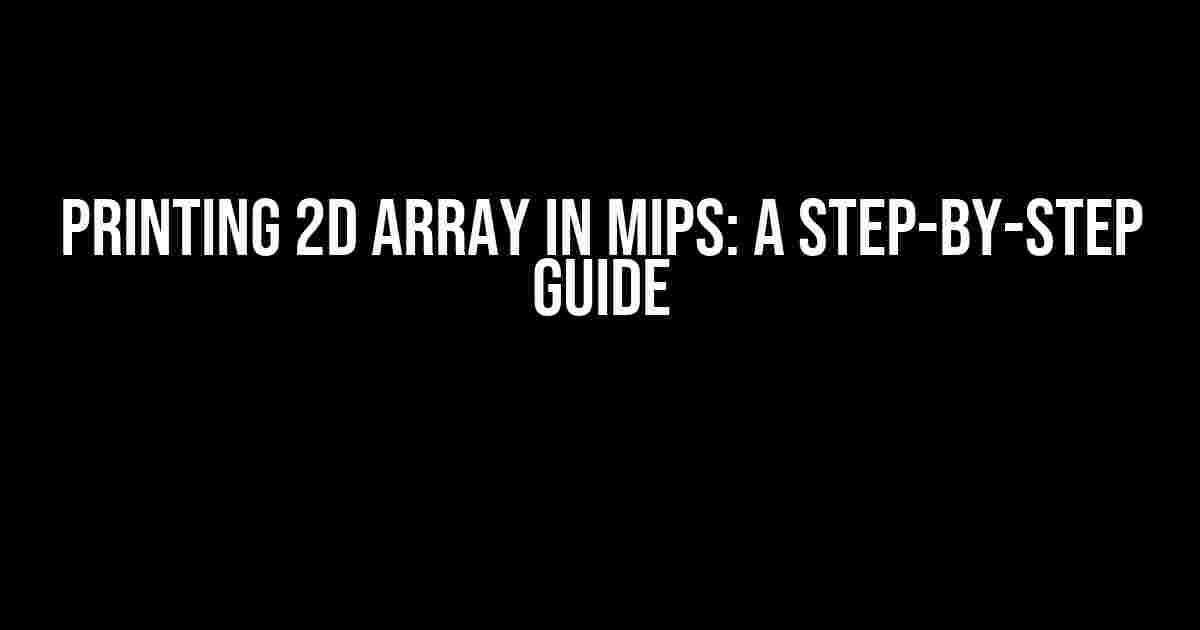Welcome to the world of MIPS assembly language! In this article, we’ll dive into the depths of printing 2D arrays in MIPS. You’ll learn how to declare, initialize, and print 2D arrays using MIPS instructions. By the end of this article, you’ll be a pro at printing 2D arrays in MIPS.
What is a 2D Array?
A 2D array is a matrix of values arranged in rows and columns. Imagine a spreadsheet with rows and columns, where each cell contains a value. In MIPS, we can declare and initialize 2D arrays using the `.word` directive.
Declaring a 2D Array in MIPS
To declare a 2D array in MIPS, we use the `.word` directive followed by the array name, dimensions, and values. The general syntax is:
.data
array: .word [rows*columns]
In this example, `array` is the name of the 2D array, and `rows*columns` represents the total number of elements in the array.
Initializing a 2D Array in MIPS
To initialize a 2D array in MIPS, we can use the `.word` directive with values. For example:
.data
array: .word 1, 2, 3, 4, 5, 6, 7, 8, 9
This 2D array has 3 rows and 3 columns, and it’s initialized with values from 1 to 9.
Printing a 2D Array in MIPS
Now that we have declared and initialized our 2D array, let’s print it to the console. We’ll use a combination of MIPS instructions to iterate through the array and print each element.
The Algorithm
Here’s the algorithm to print a 2D array in MIPS:
- Load the base address of the array into a register.
- Initialize row and column indices to 0.
- Use a nested loop to iterate through the array.
- Load each element from the array into a register.
- Print each element to the console using the `syscall` instruction.
- Increment the row and column indices and repeat steps 3-5 until the end of the array.
The MIPS Code
Here’s the MIPS code to print a 2D array:
.text
main:
la $t0, array # load base address of array into $t0
li $t1, 0 # initialize row index to 0
li $t2, 0 # initialize column index to 0
loop:
lw $t3, 0($t0) # load element from array into $t3
move $a0, $t3 # move $t3 to $a0 for printing
li $v0, 1 # print integer
syscall
addi $t2, $t2, 1 # increment column index
blt $t2, 3, loop # loop until end of row
li $a0, 0x0A # print newline character
li $v0, 11 # print character
syscall
addi $t1, $t1, 1 # increment row index
blt $t1, 3, loop # loop until end of array
li $v0, 0 # return 0
jr $ra
.data
array: .word 1, 2, 3, 4, 5, 6, 7, 8, 9
In this code, we use the `la` instruction to load the base address of the array into `$t0`. We then initialize the row and column indices to 0 using the `li` instruction. The nested loop iterates through the array, loads each element into `$t3`, and prints it to the console using the `syscall` instruction.
Tips and Variations
Here are some tips and variations to keep in mind when printing 2D arrays in MIPS:
- Use the `li` instruction to load immediate values into registers.
- Use the `la` instruction to load the base address of the array into a register.
- Use the `lw` instruction to load a word from memory into a register.
- Use the `move` instruction to move values between registers.
- Use the `syscall` instruction to print values to the console.
- Use the `blt` instruction to loop until the end of the array.
- To print a 2D array with a different number of rows and columns, simply change the loop counters and increment values.
Common Errors
When printing 2D arrays in MIPS, common errors include:
- Forgetting to initialize the row and column indices.
- Using the wrong loop counters or increment values.
- Not loading the base address of the array correctly.
- Not loading each element from the array correctly.
- Not printing each element correctly using the `syscall` instruction.
Conclusion
Printing 2D arrays in MIPS is a crucial skill for any MIPS programmer. By following the steps outlined in this article, you’ll be able to declare, initialize, and print 2D arrays like a pro. Remember to use the correct MIPS instructions, initialize your indices correctly, and loop through the array using the right counters. Happy coding!
| Keyword | Description |
|---|---|
| Printing 2D array in MIPS | Printing a 2-dimensional array in MIPS assembly language |
| MIPS | MIPS (MIPS Instruction Set) is a reduced instruction set computer (RISC) instruction set architecture (ISA) |
| 2D array | A 2-dimensional array is a matrix of values arranged in rows and columns |
| .word | The .word directive is used to declare and initialize a 2D array in MIPS |
| la | The la instruction is used to load the base address of the array into a register |
| lw | The lw instruction is used to load a word from memory into a register |
| move | The move instruction is used to move values between registers |
| syscall | The syscall instruction is used to print values to the console |
By following this guide, you’ll be able to master the art of printing 2D arrays in MIPS. Remember to practice and experiment with different examples to reinforce your understanding. Happy coding!
Frequently Asked Question
Get ready to uncover the secrets of printing 2D arrays in MIPS!
Q1: How do I store a 2D array in MIPS?
In MIPS, you can store a 2D array by declaring a single-dimensional array and calculating the index manually. For example, if you have a 3×3 2D array, you can declare it as a 1D array of size 9. Then, to access the element at row i and column j, you can use the formula: `index = i * number_of_columns + j`. This way, you can store and access 2D arrays efficiently in MIPS!
Q2: How do I print a 2D array in MIPS?
To print a 2D array in MIPS, you can use a nested loop to iterate over the rows and columns of the array. Inside the loop, use the `la` instruction to load the address of the array element, and then use the `lw` instruction to load the value of the element. Finally, use the `syscall` instruction with code 1 to print the value as an integer. Don’t forget to print a newline character after each row!
Q3: How do I format the output of a 2D array in MIPS?
To format the output of a 2D array in MIPS, you can use the `syscall` instruction with code 4 to print a string. Before printing each element, print a space or a tab character to separate the elements. After each row, print a newline character to move to the next line. You can also use a loop to print a row of dashes or a border around the array to make it look more visually appealing!
Q4: Can I use a recursive function to print a 2D array in MIPS?
Yes, you can use a recursive function to print a 2D array in MIPS, but it’s not recommended. Recursive functions can be tricky to implement and may cause stack overflow errors if not handled properly. In MIPS, it’s generally easier and safer to use iterative loops to print 2D arrays. However, if you’re up for the challenge, go ahead and try implementing a recursive function – just be sure to handle the stack carefully!
Q5: Can I print a 2D array in MIPS with dynamic dimensions?
Yes, you can print a 2D array in MIPS with dynamic dimensions, but it requires some extra effort. You’ll need to store the dimensions of the array in separate variables and use those variables to calculate the index of each element. Then, use a nested loop to iterate over the rows and columns of the array, using the dynamic dimensions to determine the bounds of the loop. It’s a bit more complicated, but it’s definitely doable with some careful planning and coding!



